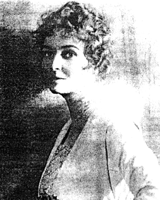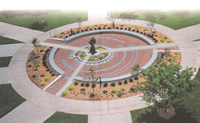
Elizabeth A. McLean
is honored with a Brick from McLean Science/Technology Magnet.

In the middle of the winter, in the middle of the night, in the middle of what was then Canada’s unsettled frontier, miles away from civilization, in a raging blizzard that was recorded as one of the harshest in Canada’s history, in a log cabin that was without heat, indoor plumbing or electricity, on the outskirts of what is today Winnipeg, Manitoba, on the 17th of November in the year 1897, Elizabeth Anna Mabry (McLean) was born.
The harsh environment which greeted her upon her entrance into this world was in many ways an indication of times to come. Yet Elizabeth’s long and fruitful life – a life lived in 3 centuries – is a story that is remembered not merely for its achievements, but also for the courage and hope that it continues to inspire in others. For it was through her tireless hard work, determination, honesty and faith that Elizabeth would rise from her humble origins, through very difficult times, to leading positions in which she would contribute significantly to the development of one of the most prosperous cities in the American Midwest.
The youngest of 5 surviving children, Elizabeth was born in the Canadian wilderness where her father, a rugged adventurer, had been attracted by the fur-trade industry of the late 1800s. A 6th child, born 2 years after Elizabeth, was not as fortunate as the other children, and, after a few brave months of life, did not survive the extreme elements of this wild and northern frontier. Elizabeth’s parents returned with their remaining children to the U.S. shortly thereafter, settling in Hutchinson, Kansas.
Both parents had a deep love of music, and as a child Elizabeth enjoyed composing her own songs and accompanying her father, an accomplished violinist, on a small organ that he had purchased for her. When Elizabeth was about ten years of age, her parents divorced. Her mother remarried within a few years, but died at the age of 41. Meanwhile, Elizabeth’s natural father had continued to journey farther and farther westward, and it was not long before his children lost his exact whereabouts as well as all contact with him. Elizabeth’s three older brothers had all joined the military, and her older sister was married and living elsewhere with a family of her own. With the death of her mother in 1911, Elizabeth found herself alone in the world. At the age of 13, and with no other choice, she dropped out of her sophomore year of high school, took a full-time job and began supporting herself independently.
After a few years, Elizabeth moved from Hutchinson to Wichita, where she worked as a bookkeeper for the sale of a strange new invention: the car. But this odd contraption was slow to become popular, and her salary in this line of business was not very substantial. With the approach of the winter season, she visited the Fourth National Bank to request a loan with which to buy a winter coat; her loan was approved by none other than the President of the bank himself, Benjamin Franklin McLean, who would later become Elizabeth’s father-in-law. Today Ben McLean is best remembered not merely for his leadership at the Fourth National Bank, but also for the 3 terms in which he served as Mayor of Wichita during some of the most formative years of the city’s early history. McLean Boulevard is named for him, as is the Ben F. McLean Science/Technology Magnet Elementary School in west Wichita, as well as a bridge downtown.
Additionally, in the 1930s the city of Wichita erected the memorial
fountain which still stands today at the corner of Douglas Avenue and McLean Boulevard in downtown Wichita, on which is engraved the inscription: “In memory of Ben F. McLean, 1858 – 1930, whose life and labors contributed greatly to developing Wichita.”
It was Ben F. McLean who brought Elizabeth to the attention of his son, Benjamin Drew McLean, who was at that time employed as an officer at the Fourth National Bank. A graduate of Harvard’s class of 1913, Drew had returned to Wichita after leading a regimen in France during World War I, and he and Elizabeth were married in 1919. They then moved to New York city where they would live for the entire decade of the “roaring twenties”. During these years Elizabeth enrolled as an art student at New York’s National Academy of Design, where she discovered her gift for painting, winning many coveted awards for her portraits, especially her Rembrandt studies. In 1929 Ben McLean senior was planning to retire from his Presidency of the bank, so Elizabeth and Drew returned to Wichita, and Drew became the bank’s Vice President. Before he could retire, however, in 1930 Ben McLean died unexpectedly. Drew was then elected to succeed his father as President of the Fourth National Bank. In
addition to their own 2 children, Elizabeth and Drew took in the 3 young children of one of Elizabeth’s brothers whose wife had died shortly after the birth of their third child. While raising these 5 children, Elizabeth and Drew also brought Drew’s mother and aunt into their home, and provided for each of these elderly ladies until their deaths.
Toward the end of World War II, Elizabeth’s and Drew’s son, Ben, was killed at the age of 23 while fighting as a paratrooper in the Battle of the Bulge, leaving behind a wife and a one-year-old daughter. Meanwhile, Elizabeth’s and Drew’s daughter, Julianne, who had graduated from high school at the age of 16, was showing promising young talent as a concert pianist, and was awarded a full scholarship to study at the Kansas City Conservatory of Music. After completing her Bachelor’s and Master’s degrees there, she then continued her studies at New York’s Juilliard School of Music, and then in Italy at Rome’s Santa Cecilia Academy of Music. It was during one of her transatlantic crossings that Julianne found herself aboard the Italian luxury liner, the Andrea Doria, in 1956 when it was struck by the Swedish liner, the Stockholm, and sank. Although she lost all of her personal belongings in this maritime disaster, she was rescued by the French liner, the Ile de France, and was
transported safely to New York, unharmed.
When Ben McLean senior was Mayor of Wichita, he had purchased 464 acres of farmland in 1908. He always maintained an active interest in this land, and had enjoyed tilling it himself until the final days of his life. Upon his death, his land was distributed among his descendents, with Elizabeth and Drew inheriting 138 acres. They never intended to use this land for anything other than farming, but in the 1950s the city of Wichita re-zoned their farmland to be included within the city limits, and an increase in taxes soon followed. Widowed by now, and solely responsible for 138 acres of highly taxed land, Elizabeth divided the land into half-acre and full-acre sections and sold the lots for residential development. She named the new residential communities “Benjamin Hills Estates”, and the “Benjamin Hills 2nd Edition”, in memory of her son. Preserving the natural hills and trees of the land, she routed and named all of the streets within the development as well, using names that reflected her love of nature, with every street named after a bird, a flower or a tree – the only exceptions being Benjamin Street, named for her son, and McLean Blvd., named by the city after her father-in-law. In 1955 Elizabeth donated to the Board of Education the land for the construction of McLean Elementary School, next to which construction also began on her land for Sweetbriar Shopping Center, Twin Rivers Swim Club, and a church. The city honored Elizabeth by naming 2 streets after her, Elizabeth and Anna Streets, and one after her daughter, Julianne Street.
In 1959, Elizabeth single-handedly won a fight against the Kansas State Legislature, which had designated construction of Interstate 235 through the newly developed residential district, and which would have required the destruction of many newly built homes. Undeterred by the fact that she had just broken her arm, Elizabeth drove herself, alone, with one arm in a cast, to Topeka and waited for several hours to meet with the Governor and his commissioners. She was then able to demonstrate with aerial photographs how the state could save money by building the new highway along the existing riverbed instead of through a residential community, thereby also sparing many homes from destruction. Agreeing with Elizabeth, the Governor ordered the engineers to re-draw their blueprints: the northwest section of I-235 was then constructed according to Elizabeth’s recommendations, and many homeowners were allowed to keep their homes.
Upon being diagnosed with uterine cancer in the early 1960s, Elizabeth’s only response to her doctor was, “Does this mean that I may still play bridge on Saturday?” After surviving two World Wars, the loss of her parents, all of her siblings, her husband, her only son, and the narrow escape of her only daughter from a sinking ship in the Atlantic ocean, the possibility of her own brush with death did not seem to be cause for much alarm.
One of Elizabeth’s greatest pleasures was travel. Since the 1950s, she journeyed every few years to new foreign destinations, having circled the globe, both by air and by sea, on more than one occasion. Her last trip, in which she traveled by ship through the Amazon in 1994, at the age of 97, ranked among her favorites.
In November of 1997, Elizabeth Anna McLean was recognized on her 100th birthday by family, friends and members of the community at the Wichita Art Museum, at which Wichita’s then Mayor, Bob Knight, presented her with a Medal of the City and referred to her as “the last of the early Wichita matriarchs”. The event also marked Elizabeth’s first art exhibit since the 1920s, featuring many of her original oil paintings from her days as a young art student at New York’s National Academy of Design. Family members present at the event included 5 generations of descendents.
While still living in her own home, which she had designed and built nearly half a century earlier, Elizabeth A. McLean passed away peacefully and without illness in May of the year 2000, at the age of 102.










